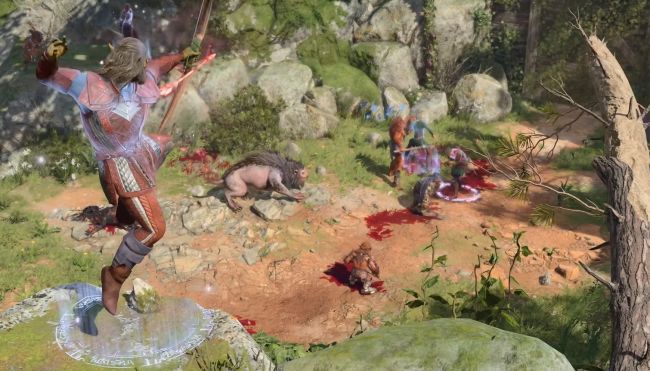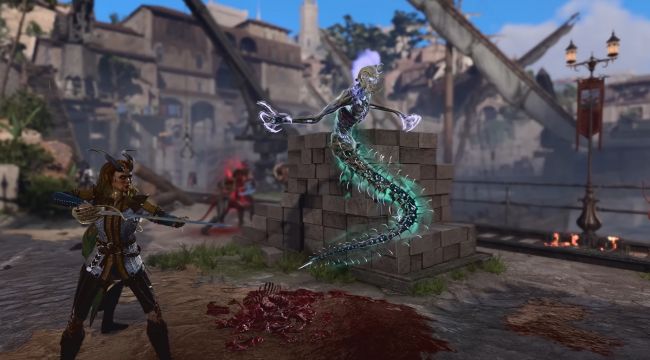Baldur’s Gate III Patch 8 is out now, and in addition to a host of changes, bug fixes and more, it gives us a whopping twelve new subclasses to enjoy, giving each main class one more option when it comes to specialization. If you want to make a charismatic villain or study the stars as a druid, here are each of the subclasses, with a simple guide to what they’re good at.
Barbarian – Path of Giants
Starting with the toughest, meanest class out there, the Barbarian gets a subclass that focuses on the elemental powers and size of giants. You get bigger as you rage, and also gain the ability to throw things and people over greater distances. Perfect for when a difficult boss is a little too far from the bottomless pit you want to throw him into. If you don’t have your hands free, the Boots of the Giants bonus action also lets you kick a target a good distance away. Additionally, if you plan to be the mule of the party pack, you get more carrying capacity with your giant bags. The Giants’ elemental powers also allow you to infuse weapons and thrown attacks with different types of elemental damage.
Bard – College of Glamour
If you thought your bard just wasn’t fantastic enough, you can now give them an extra sparkle with the College of Glamour. The College of Glamour subclass largely focuses on charming both allies and enemies and can grant temporary HP to allies, putting enemies at risk of being charmed when they attack them. The Mantle of Majesty also lets this bard command enchanted enemies, causing them to flee, drop their weapons, cower or do anything else you might want them to do (within reasonable limits and game mechanics, of course).
Spiritual – Domain of Death
Death Domain Clerics have really proved that they were not just in an emo phase and have given themselves to the lifestyle with all their heart. They are into necromancy, with new cantrips like Toll the Dead and additional spells to give them a more evil and edgy vibe. You can also explode enemy bodies for more damage, and infuse weapon attacks with extra necrotic damage if you go for a more melee-focused Cleric build.
Druid – Circle of Stars
This one is for the astronomy girls. Instead of using your Wild Shape to turn into animals, you can use the charges to get certain star shapes that give bonuses. Dragon gives you a minimum roll of 10 on concentration checks, as well as the Dazzling Breath bonus action, Chalice gives a new skill that is used when you heal someone with a spell lock, and Archer lets you sound enemies away for extra damage with a bonus action. You can also use all your spells while in Starry Form, and these forms will increase in power as you level up, making them a tempting alternative to just becoming an Owlbear and crushing everyone.
Fighter – Arcane Archer
Like the Battle Master, the Arcane Archer gives Fighters new attacks that can do extra damage, strengthen them and debuff enemies. Starting at level 3, they can devise new ways to infuse your ranged attacks with magic. Curving Shot also allows you to hit another enemy within range, even if you miss your intended enemy. Like the bullet from Wanted that curves, but in a fantasy setting. Some new shooting animations have also been added, but for the most part, as with other Fighter subclasses, the main goal here is simply to hit enemies and keep hitting them until they are dead.
Monk – Away from the drunken master
Channeling all the energy of an MMA spectator who just finished his ninth pint, the Drunken Master believes they can take out any enemy while being absolutely blistering. The only difference is that the Monk subclass is actually right about that. Drinking alcohol restores Ki for the Drunken Master, and they can also slam their booze into an enemy, making them unstable while the Monk in turn gets a buff. When an enemy is drunk, the Drunken Master also gains access to new attacks, which deal more damage to their drunken targets.
Paladin – Oath of the Crown
The greatest law enforcer if there ever was one in the world of Dungeons & Dragons, the Oath of the Crown Paladin believes that the only rules worth following are those of the law, serving society and civilization rather than necessarily a god or patron. Divine Allegiance allows them to take incoming damage to allies and restore their health, and Champion Challenge makes all enemies want to hit you instead of your friends. Just make sure you build a tank when you take this class. There is also some new knowledge attached to this oath, as well as a new scolding from the Oathbreaker Knight if you fail to maintain law and order.
Forester – Swarmkeeper
If you like the idea of being surrounded by bees or hive-minded, insect-like spirits, then you will first of all get dirty and secondly probably enjoy Swarmkeeper Ranger. Three different swarms can surround you in battle. The Legion of Bees can attack and deal penetrating damage, push enemies away or teleport you to a safe location. The Cloud of Jellyfish can deal lightning damage, shock enemies and also teleport. The Flurry of Moths deals psychic damage, can blind enemies and, as with the others, it can also teleport. If you don’t quite like your bees and want to trade them for moths, you can switch swarms each level.
Villain – Swashbuckler
Ahoy, buddy, if you don’t like sneaking in the shadows and instead want to be at the front of battles, then the dirty fighting of a Swashbuckler will offer a whole different way to play Rogue. Throwing sand in your enemies’ eyes gives you the chance to blind them, and you can disarm enemies by throwing your own weapon at them as well. And when you attack an enemy, they won’t be able to take opportunity attacks against you if you decide you don’t actually want the smoke.
Wizard – Shadow Magic
Remember when we talked about the Death Domain Cleric as the supreme edgelord? Well, the only challenger to that title is the dark Shadow Magic Sorcerer, who gets their power from the Shadowfell. With the ability to avoid lethal damage, instead dropping to 1HP upon reaching 0, and being able to teleport in low light or darkness, summon a deadly shadowhound and even see through magical darkness, this subclass is more than just a lot of black eyeliner and musty t-shirts. You also get some extra, twisted spells to add to your wizard.
Warlock – The Hexblade
The Hexblade Warlock also gets their power from the Shadowfell and is all about killing with his Hexed weapons, allowing him to turn hooded humanoid enemies into twisted creatures of the Shadowfell. Your extended spells help you stay in the fight and do extra damage, and when you reach 10th level, you even have a 50% chance of nullifying every attack with a reaction. You’ll also almost certainly want to combine this with the Pact of the Blade Boon at level 3 to maximize your melee potential.
Wizard – Bladesing
Melee Wizards, who would have thought? With almost every school of magic already covered in the already existing wizard subclasses, Larian has stepped to the side of what you would expect from a wizard, and given us Bladesinging. Bladesingers get access to the Bladesong action, giving them bonuses to dodge, Constitution saving throws and their melee attacks. There are also some fun spell animations for when a wizard has a sword, which adds a nice touch.
Of course, we haven’t discussed every upgrade you get with these subclasses, but from this list, hopefully you know what you’re getting into when choosing the subclass for your new Tav or Durge. Which one will you choose?





